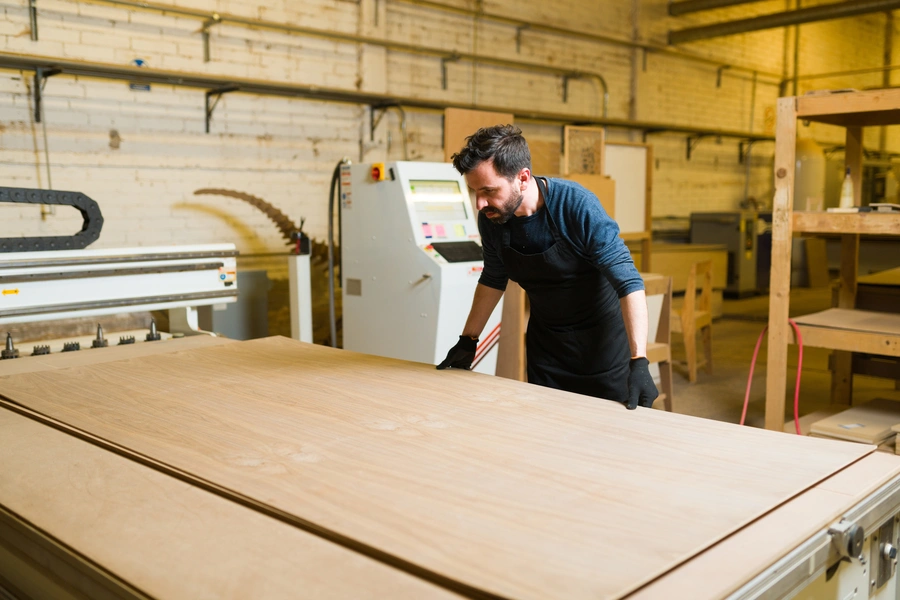Studies have shown that accidents related to woodworking are most likely to occur while using circular saws, wood shapers, and surface planers. Although the danger of injury is widespread throughout the whole woodworking industry, it is particularly high when using these three types of machinery.
While overseeing construction projects involving carpenters or joiners, you may considerably reduce the risk that your employees face by being familiar with conventional safety solutions and encouraging your workers to adopt best practises when dealing with common forms of hazardous machinery. When your employees are using woodworking machines, you should use the following measures to ensure that they behave in a safe and consistent manner.

Solutions to Safety Concerns
In order to reduce the number of typical accidents and injuries that occur in the construction industry, your organisation can apply many company-wide solutions. These preventative measures may be implemented on a wide variety of equipment, and in certain circumstances, they can even be obligatory.
- Workers are protected from harm when tools that have run down but have not ceased moving are slowed down by braking mechanisms. When employees shut down a machine and let it to power down without monitoring it, an uncontrolled hazard is created. Cutting tool cooldown times are reduced by braking devices. Your risk evaluation may necessitate the purchase of a brake device for your equipment.
- A worker’s hands are less likely to come into contact with a revolving cutter when using chip-limited tooling solutions. When using chip-limited tooling, the cutter can extend no farther than 3 mm from the tool, leaving just a thin sliver of space through which an employee may be harmed. There are occasions when a number of hand-fed machines need to be outfitted with chip-limited tooling.
Best Practices
It might be simple to group all of the many types of machinery used in the woodworking industry together and use the same best practises on each one, but it is risky thinking because there are so many distinct types of machinery. You must take into account each machine independently in order to foresee the vast majority of incidents that take place when utilising machines. The most typical pieces of equipment that joiners and carpenters use are briefly described here, along with some best practises for their use.
- The majority of incidents involving circular saws in the woodworking industry result in finger amputations. They are typically employed for cutting against the grain. Equip your circular saws with top guards and always-adjusted riving knives for every new project. Your circular saws should feature a brake mechanism if their rundown time is greater than 10 seconds. Use local exhaust ventilation (LEV) to keep wood dust under control.
- Saws that cut in a crosswise direction are known as cross-cut saws. These machines can have their blades situated either above or below a table. To evaluate the exact dangers posed by your cross-cut saw, you need carry out a risk assessment. It is recommended that every cross-cut saw be equipped with a proper cover and a brake mechanism. Create a no-hands zone measuring 300 millimetres on either side of the blade where people cannot put their hands.
- Grooving, moulding, and rebating of curved and straight wood are produced by wood shapers. If your moulders have a rundown time more than 10 seconds, you should install them with brake mechanisms.
- During the first preparation of wood, surface planers produce flat faces and square edges. Bridge guards prevent employees’ fingers from coming into contact with the cutter; set yours at 10 millimetres or less, but remember to change it before each task to avoid the machine becoming stuck with a non-uniform size.
- Sanders are used to even out rough spots in wood. Disc, spindle, and belt are the three most common. All three increase the need for wood dust control, but each has its own unique dangers. Use a local exhaust ventilation (LEV) system to remove potentially hazardous dust, and a dust lamp to monitor the dust generated by your employees and evaluate the effectiveness of your LEV system.
- One of the most useful equipment for your staff members is a nail gun, which is significant in many elements of carpentry. When not about to fire, workers shouldn’t retain their finger on the trigger, and they should always wear eye protection in case of inadvertent ejection. The nail gun should never be pointed at the user or anybody else.
- Mortisers create rectangular or square holes in wood. When utilising the equipment, employees must maintain an 8-millimeter space between their hands and the morticer’s chisel. Make it mandatory for workers to clamp the wood they are cutting rather than holding it by hand, which can be hazardous and unstable.
Demand That Only the Best Practices Be Used
Even when limiting oneself to the most conventional woodworking machines, the sheer quantity of safety solutions and recommended practises can be overwhelming. However, due to the dangers inherent in the field, you must acquire this knowledge and share it with your staff. Ensure that your workplace is free of accidents by requiring the implementation of safety measures.
